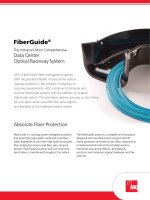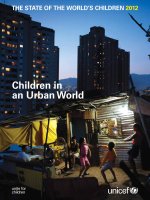Building the World’s Most Sustainable City potx
Bạn đang xem bản rút gọn của tài liệu. Xem và tải ngay bản đầy đủ của tài liệu tại đây (3.53 MB, 39 trang )
September 10
Building the World’s
Most Sustainable City
What is Masdar City?
A Sustainable City
providing the highest quality
of life with the lowest
environmental footprint.
100% Renewable Energy
Zero Waste
Net Zero Carbon
Fossil Fuel Free Zone
What is Masdar City?
Initiative of the Leadership of the Emirate
of Abu Dhabi
Site area: 700 hectares / 7 Sq/KM
Mixed use city
Population:
40,000 residents
50,000 commuting
= 90,000 people
MASDAR
Abu
Dhabi
Airport
Yas Island
(Formula 1)
Saadiyat Island
(Louve)
(Guggenheim)
Khalifa
City
Abu Dhabi
Agenda
What makes Masdar City Unique?
Traditional Arabic City Design
Narrow streets
Natural shading
High Density
/Low Rise Living
Public spaces
Mixed Use
Walkable
Fez
People and Community
High Density /
Low Impact
Public
Squares
Mixed Use
Development
p8
Sense of Place
Research and
Learning
Architecture
Quality of Place
p10
Life in Masdar City – Masdar HQ Interior
p11
Life in Masdar City – Civic Square
p12
Life in Masdar City – Streetscapes
p13
Life in Masdar City – Terrace
p14
What makes Masdar City Unique?
A graduate-level, research-driven institution in partnership
with MIT
Masdar
Institute
The City will strive towards a zero waste objective
Recycling /
Waste to
Energy
The City will contain pioneering public transportation
systems
Innovative
Transporta-
tion System
Building design will ensure the latest use of energy efficient
technologies and smart design
Building
Design
The City will be powered with Renewable energy
Renewable
Energy
p15
Building Design
Waste
Transportation
Energy
Generation
Design of a conventional city
Conventional Oil & Gas Landfill
Fossil fuel
80% 13% 7%
1,100,000 Tonnes CO
2
Design of Masdar City
Energy Efficient Renewable
Recycling /
Waste to Energy
Electric /
Solar
-56% -24% -12%
-7%
= 0 CO
2
Carbon offsetting /
Carbon Sequestration
-1%
Building Design Waste
Transportation
Energy Generation
Energy
100% Powered by Renewable Energy
170MW from Photovoltaic
<30 KWh per capita per day
energy usage (9x LESS than USA)
100% Renewable Energy Solutions
Concentrated Solar Power (26%)
Photo Voltaic (53%)
Evacuated Thermal Tube
Collector (14%)
Waste to Energy (7%)
MASDAR Water Strategy
Reduce water
leakage to 3%
Recycle 90%
of grey water
Reduce consumption
to <80l/p/d
p20
Bundled projects scenarios – Onsite vs Regional
On-Site Scenario:
Study for On-Site Groundwater use
Seawater or Off-Site GW supply w/
on-site desalination
Brine Treatment and Reuse
Local Waste for 3 MW WtE
Regional Scenario:
ADDC Water Supply
Regional Waste for 10 MW WtE
CSP from Small Square
Game Changing
Issues:
Green Buildings
Hydro Study re GW
Volume
WtE Demand
Geothermal Resource
On-site Desalination
Greywater Recycling
PRT vs. Metro
Small Square Timing
MissesMeets
CH2M HILL Proprietary - Reuse Prohibited
On-Site scenario description
September 10
p22
Base Projects & Primary Projects
– Dry MRF + In-Vessel Composting
– Biomass burner – construction wood waste
– Waste minimization and AWCS
– Alternative water options-Dew/Fog collector
– Reduce undercroft lighting and ventilation
– Reduce non-resident building electrical load
– Geothermal energy + pumping to demand
– Reduce street lighting load
– Add 1 MW PV ground mount to 10 MW farm
– Eliminate blackwater treatment electrical load
– use biogas from anaerobic digestion
– Reduce water distribution energy load
– Water supply from seawater or groundwater
– RO desalination plant on-site
– Flora/Fauna/Wildlife/People optimization
Secondary Projects
– Install 3 MW WtE for non-recyclables
– Increase rooftop PV generation + cleaning
– develop recycle market
– Study on-site hyper-saline ground water
– Brine treatment and reuse of products
– Increase CSP electrical/thermal cooling ratio
– Increase electrical distribution efficiency
– Reduce ICT and PRT demand
Use Seawater or Off-Site Ground Water for potable water w/Green Power
at intake or well location
On-site Desalination, Brine Management & Reuse
All Energy Projects in top 31 ranked Roadmaps
11% Energy gap compare to 31% gap
for demand < 40% AD reference w/Roadmaps
28% Energy gap compare to 44% gap
for 10% better than AD reference results
0
500
1000
1500
2000
2500
3000
May-08
Nov-08
May-09
Nov-09
May-10
Nov-10
May-11
Nov-11
May-12
Nov-12
May-13
Nov-13
May-14
Nov-14
May-15
Nov-15
May-16
Nov-16
May-17
Nov-17
Months
MWh/day
Baseline Demand 10% AD Reference Onsite Electric Supply Current Onsite Demand Current Baseline Demand
On-Site Scenario
Electrical Supply vs. Demand
CH2M HILL Proprietary - Reuse Prohibited
Onsite cost-benefits: demand comparisons
Develop & Strategy Investment = $46 million
Spending in 2009 = $14 million
Spending in 2010 = $25 million
Spending in 2011+ = $ 7 million
Notes:
1. Cost shown are based on current information and therefore order-of-magnitude (+50%, -30%) in nature for comparison purposes only. Once a scenario(s) is selected, a more thorough and
detailed delivery plan and cost estimate will be prepared.
2. Investment to concept noted above includes investigation studies, pilot project, demonstration and feasibility studies only.
Scenario 1a
0
20
40
60
80
100
Energy
Water
Waste
Biodiversity
Goal Scenario 1a
Projected Demand <40% of AD reference
Demand <10% of AD reference
1. Develop
& Strategy
2. Concept
Design
3. Delivery
4.
Operations
5. Feedback
Scenario 1
0
20
40
60
80
100
Energy
Water
Waste
Biodiversity
Goal Scenario 1
11% E Gap
0% W Gap
30% B Gap
28% E Gap
0% W Gap
30% B Gap
CH2M HILL Proprietary - Reuse Prohibited
Regional scenario description
September 10
p24
Base Projects & Primary Projects
– Dry MRF + In-Vessel Composting
– Biomass burner – construction wood waste
– Waste minimization and AWCS
– Alternative water options-Dew/Fog collector
– Reduce undercroft lighting and ventilation
– Reduce non-resident building electrical load
– Geothermal energy + pumping to demand
– Reduce street lighting load
– Add 1 MW PV ground mount to 10 MW farm
– Eliminate black water treatment electrical load –
use biogas from anaerobic digestion
– Reduced demand from small square delay
– Water supply from ADDC
– Flora/Fauna/Wildlife/People optimization
Secondary Projects
– Install 10 MW WtE for non-recyclables + additional
imported waste
– Increase rooftop PV generation + cleaning
– develop recycle market
– CSP production on small square
– Increase CSP Electrical/Thermal cooling ratio
– Increase Electrical Distribution efficiency
– Reduce ICT and PRT demand
Use ADDC for majority of potable water supply
Import waste for WtE Generation
Determine ROI for Small Square CSP
3% Energy gap compare to 31% gap
for demand < 40% AD reference
21% Energy gap compare to 44% gap
for 10% better than AD results
0
500
1000
1500
2000
2500
May-08
Nov-08
May-09
Nov-09
May-10
Nov-10
May-11
Nov-11
May-12
Nov-12
May-13
Nov-13
May-14
Nov-14
May-15
Nov-15
May-16
Nov-16
May-17
Nov-17
Months
MWh/day
Current Regional Demand Regional Electric Supply Regional Demand 10% Abu Dhabi Current Baseline Demand
CO
2
e concept
Embedded CO
2
e
•Buildings & Platform
(Dcarbon8)
•Infrastructure (TBD)
•Regional Infrast. (TBD)
Operations CO
2
e
•Infrastructure (McKinsey)
•Utilities (McKinsey)
Embedded CO
2
e
•Food (TBD)
•Flora/Fauna (TBD)
•People choices (TBD)
CO
2
e Balance
Results in
6 months
to
2+ years
Concept
Design
in
9 months









